As a feline aficionado, you’ve undoubtedly observed the insatiable curiosity of your furry companions. Cats, those enigmatic creatures of habit and mystery, have a knack for exploring their environment with a whimsical blend of caution and courage. But what happens when that exploration leads them to your candy stash? This tantalizing question forms the heart of our discussion: Can cats eat candy? It’s a query that’s as sweet as it is serious, and we’re here to delve into the nitty-gritty details, examining the potential repercussions and remedies, the toxic thresholds, and the tantalizing tastes that might tempt your feline friend.
Imagine the scene: a rainbow of candy wrappers scattered across the floor, your cat’s eyes wide with innocence and perhaps a hint of mischief. Before you surrender to the undeniable cuteness of the moment, it’s crucial to understand the potential dangers lurking beneath the sugary surface. The question, “Is candy bad for cats?” is far from a frivolous one, and we’ll tackle it head-on, providing you with a comprehensive understanding of the potential threats and symptoms of candy poisoning in cats.
Of course, while our primary focus is on the health and well-being of our feline companions, we also acknowledge the undeniable allure of sweets. Do cats even like candy? Is there a certain amount of candy that’s toxic to cats? And what if your cat has already indulged in a forbidden treat – what can you do to help? We’ll address all these questions, providing you with the necessary knowledge to navigate these sugary waters safely.
Furthermore, we’ll delve into the specifics of popular candies like candy corn, candy canes, and candy floss. Is there a difference between them when it comes to your cat’s health? And if candy is off the menu, what are the safe alternatives to satisfy your cat’s sweet tooth? Finally, we’ll round off our discussion by exploring the best food options for cats, ensuring you’re armed with the knowledge to provide your feline friend with a balanced, nutritious diet.
So, whether you’re a seasoned cat parent or a new kitten owner, join us on this journey of discovery, where we’ll unravel the sweet mysteries of cats and candy. It’s time to satisfy your curiosity, just like your cat would!
Is candy Bad for Cats?
Yes, candy is indeed harmful to cats. Our furry companions, unlike humans, lack the ability to metabolize theobromine, a substance found in chocolate, which can lead to severe health issues. Additionally, candies often contain artificial sweeteners such as xylitol, which can cause a sudden drop in a cat’s blood sugar and, in extreme cases, could lead to liver failure. Even candies without these ingredients are loaded with sugars that can contribute to obesity and dental problems in cats. Therefore, it’s crucial to keep these sweet temptations out of paw’s reach and provide your feline friend with a diet that’s appropriate for their nutritional needs. As much as their curious eyes might plead for a taste, remember that the fleeting pleasure of a sweet treat is not worth the potential risk to their health. So, when it comes to the question, “Can cats eat candy?” the answer is a resounding no. Instead, opt for cat-friendly treats that are specifically designed to be both tasty and beneficial for their health.
Why is candy bad for cats?
In the feline world, candies are a no-go zone. Cats, unlike humans, lack the enzyme to break down a type of sugar called xylitol, which is commonly found in many candies. This inability to metabolize xylitol can lead to a rapid and dangerous drop in a cat’s blood sugar level, a condition known as hypoglycemia. Moreover, candies, especially chocolate, contain theobromine, a substance that’s toxic to cats. Theobromine can trigger a range of health problems including heart palpitations, muscle tremors, and seizures. Furthermore, the high sugar content in candies can contribute to obesity and dental issues in cats. Therefore, it’s vital to keep candies out of your feline friend’s reach.
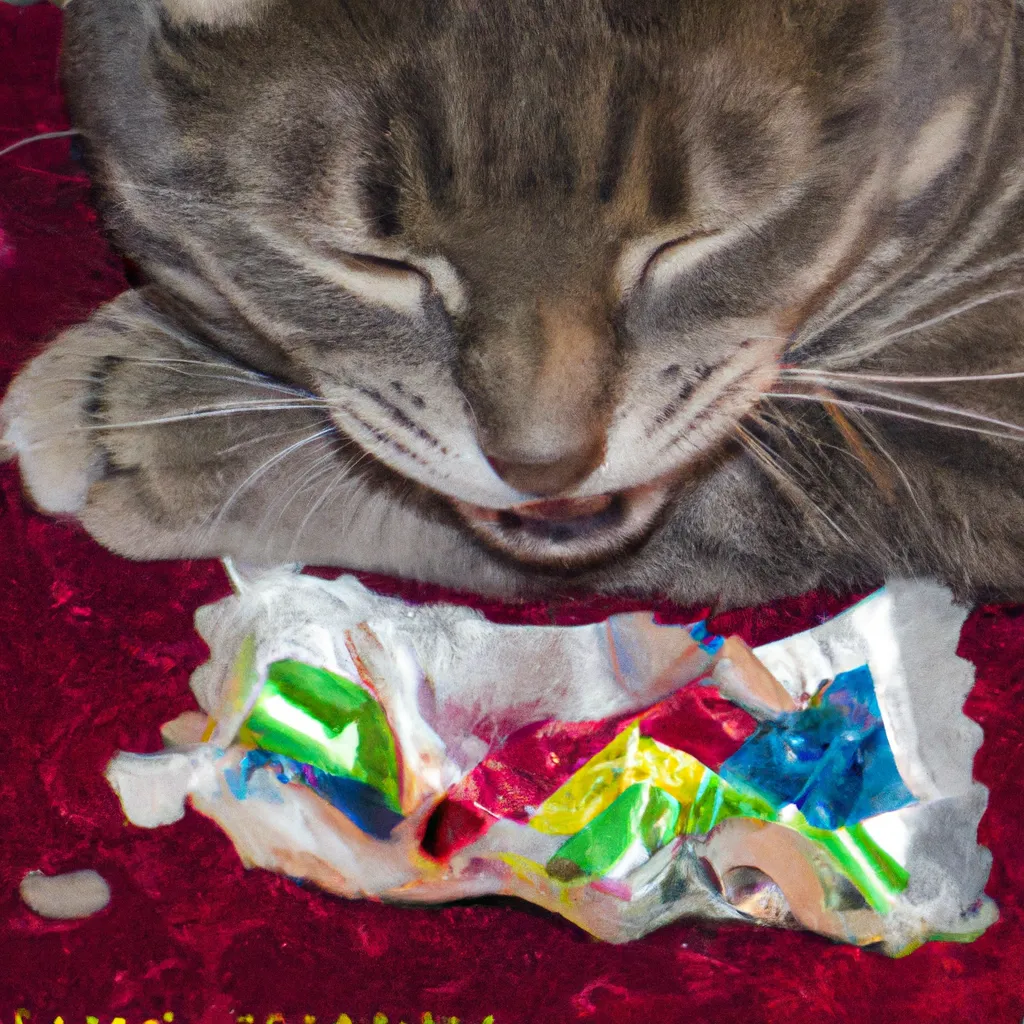
What are the symptoms of candy Poisoning in Cats?
When a cat ingests candy, symptoms of poisoning can manifest within a few hours. The most common signs of candy poisoning in cats include vomiting, diarrhea, increased thirst, lethargy, and a loss of coordination. In severe cases, the cat may experience seizures, abnormal heart rhythm, and even collapse. If your cat exhibits any of these symptoms after consuming candy, it’s crucial to seek immediate veterinary attention. Timely intervention can help mitigate the severity of the situation and increase the likelihood of your cat’s full recovery. Remember, prevention is always better than cure, so keep your candy stash well hidden from your curious feline.
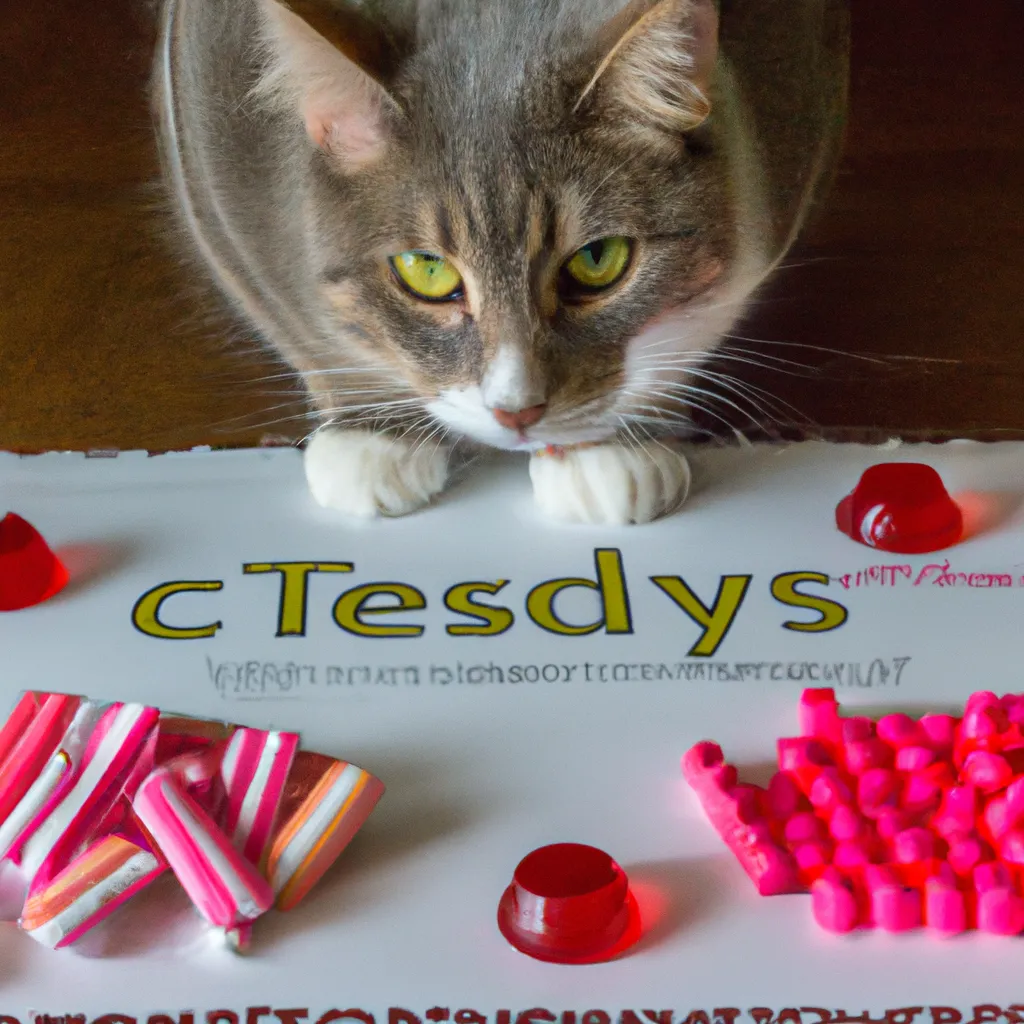
How much candy is toxic to cats?
Any amount of candy can be toxic to cats, as they are not equipped to process the sugars and artificial sweeteners often found in these treats. The specific toxicity level can vary based on the type of candy and the size of the cat, but even small quantities can lead to serious health problems. For instance, chocolate, a common candy ingredient, contains theobromine which is highly toxic to cats. Similarly, candies sweetened with xylitol, a sugar substitute, can cause rapid insulin release leading to hypoglycemia (low blood sugar), and in severe cases, liver failure. Therefore, it’s crucial to keep candies out of your feline friend’s reach and stick to cat-friendly treats instead. Remember, their unique dietary needs and metabolism make many human foods harmful, if not lethal, to them.
Can Cats Die From candy?
Yes, cats can potentially die from consuming candy, chiefly due to a toxic substance called xylitol. This artificial sweetener, often used in sugar-free candies, can trigger a rapid release of insulin in cats, leading to hypoglycemia, a dangerous drop in blood sugar levels. If left untreated, hypoglycemia can result in liver failure, seizures, and even death. Furthermore, cats lack the necessary enzymes to properly digest sugars and other sweeteners, which can lead to gastrointestinal discomfort, obesity, and dental problems. Therefore, it’s unequivocally recommended to keep candies and all sweet treats out of your feline friend’s reach, ensuring they stick to a balanced, species-appropriate diet.
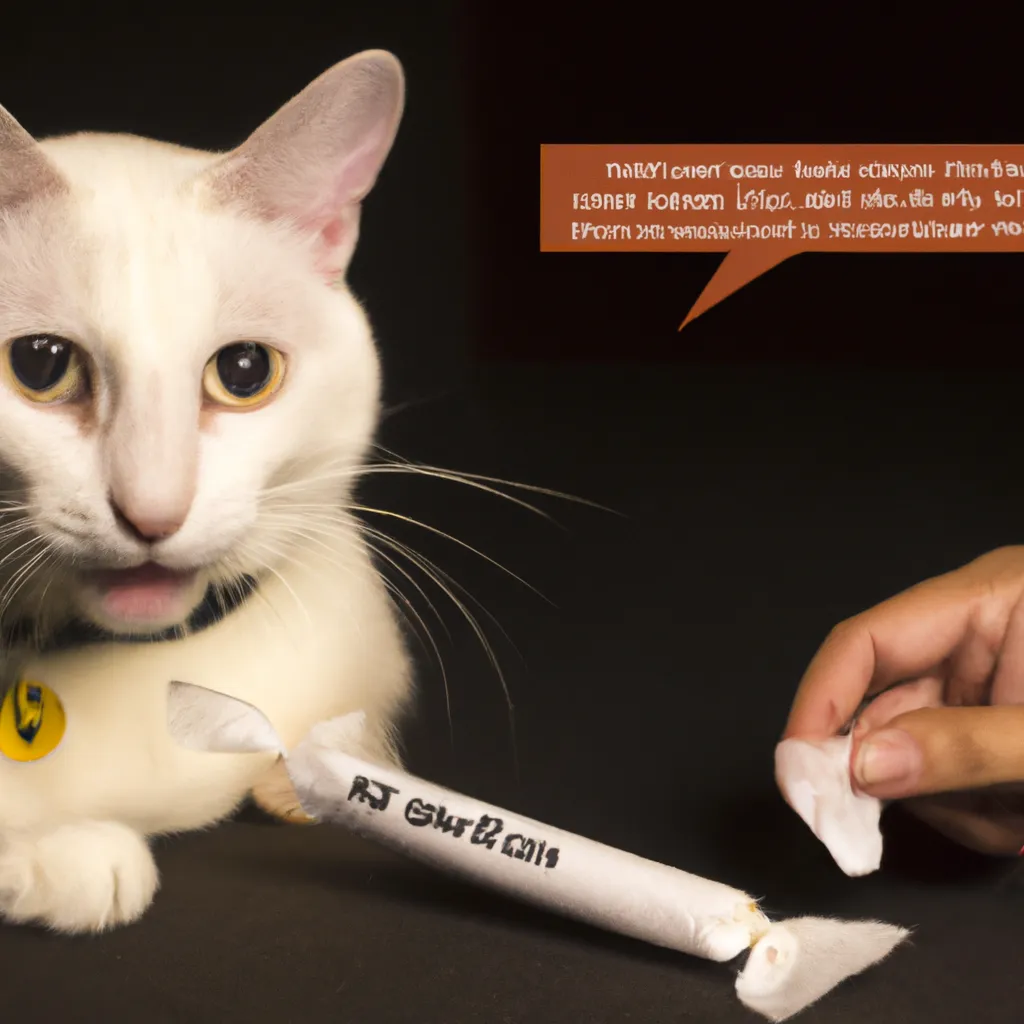
What to do if cat ate candy? How to help?
If your feline friend has ingested candy, it’s crucial to act promptly as sweets can be harmful to cats. Sugar, artificial sweeteners, and chocolate found in candies can lead to digestive troubles, obesity, and in severe cases, toxicity such as xylitol poisoning or chocolate toxicity. Initially, observe your cat for any signs of distress like vomiting, diarrhea, increased thirst, restlessness, or seizures. If any of these symptoms are present, or if the consumed candy contains chocolate or xylitol, contact your vet immediately. They may induce vomiting or administer activated charcoal to absorb the toxins. In the future, keep candies out of your cat’s reach and stick to cat-friendly treats to maintain their health and well-being.
What will a vet do if a cat is poisoned by candy?
If a cat is poisoned by candy, a veterinarian will typically spring into action with a course of treatment that’s as swift as a feline’s pounce. The vet will first perform a thorough examination to confirm the poisoning and assess the severity of the symptoms. This may involve blood tests, urinalysis, and sometimes even an ultrasound or X-ray. Once the diagnosis is confirmed, treatment may include inducing vomiting to expel the candy, administering activated charcoal to absorb the toxins, and providing intravenous fluids to help flush out the poison and prevent dehydration. In severe cases, the vet may need to hospitalize the cat for close monitoring and further treatment. Remember, time is of the essence in these situations – the quicker the treatment, the better the chances of your furry friend bouncing back to their playful self.
Do cats like candy?
No, cats don’t typically have a sweet tooth for candy. Unlike us humans who can’t resist a sugary treat, cats lack the taste receptors for sweetness. This means that while they might be intrigued by the crinkly wrapper or the unusual shape of a piece of candy, they’re unlikely to find it appetizing. However, this doesn’t mean that candy is safe for cats. On the contrary, many candies, especially those containing chocolate or artificial sweeteners like xylitol, can be extremely toxic to cats. So, while your feline friend might not be clamoring for a piece of your candy bar, it’s still crucial to keep these treats well out of their reach. After all, cats are known for their curiosity, and we wouldn’t want them to satisfy it with something that could harm them!
Is candy good (healthy) for cats?
No, candy is not healthy for cats. As obligate carnivores, cats require a diet rich in proteins and certain fatty acids, which they cannot derive from candy. Their digestive systems are not designed to handle high-sugar foods like candy. Consuming such items can lead to obesity, dental problems, and even diabetes in cats. Moreover, certain ingredients in candies, such as chocolate and xylitol (a common sweetener), are toxic to cats and can cause severe health issues, including liver failure and neurological problems. Therefore, it’s crucial to keep candies out of your feline friend’s reach and stick to a balanced, species-appropriate diet.
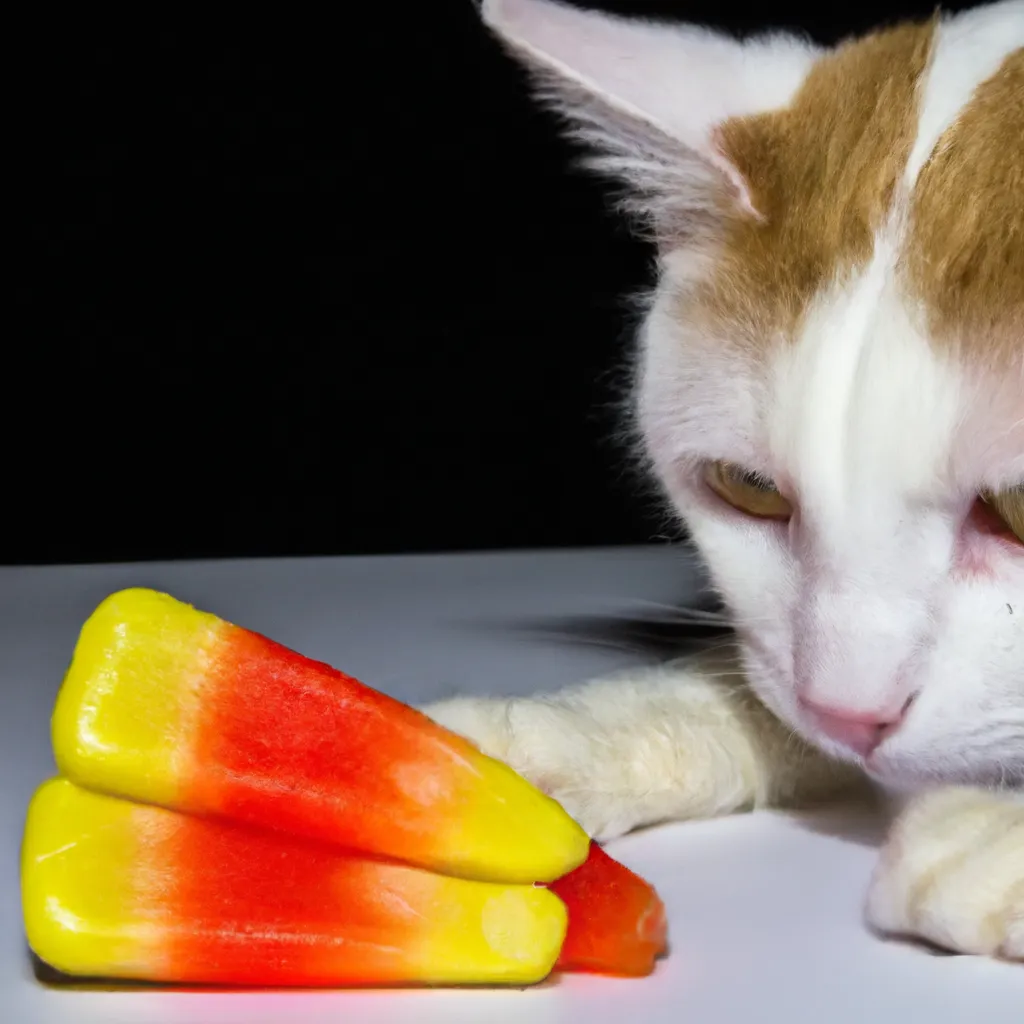
Can cats eat candy corn?
No, cats should not eat candy corn. While this popular Halloween treat might seem harmless, it’s packed with sugar and artificial colors, neither of which are beneficial for cats. In fact, the high sugar content in candy corn can lead to the same health problems as other candies, such as obesity and diabetes. Furthermore, cats lack the necessary enzymes to break down artificial colors and flavors, which can lead to gastrointestinal upset. Even a small amount of candy corn can cause your cat to vomit or experience diarrhea. Thus, it’s best to keep candy corn, like all candies, away from your feline companion.
Can cats eat candy canes?
No, cats should not eat candy canes. These holiday treats may seem like a fun snack to share with your feline friend, but they are not suitable for cats. Candy canes are full of sugar, which cats can’t metabolize properly, leading to potential health issues. Furthermore, the minty flavor of candy canes, derived from peppermint oil, can be harmful to cats. Peppermint oil contains compounds like phenols and salicylates, which can cause gastrointestinal upset, central nervous system depression, and even liver damage in cats.
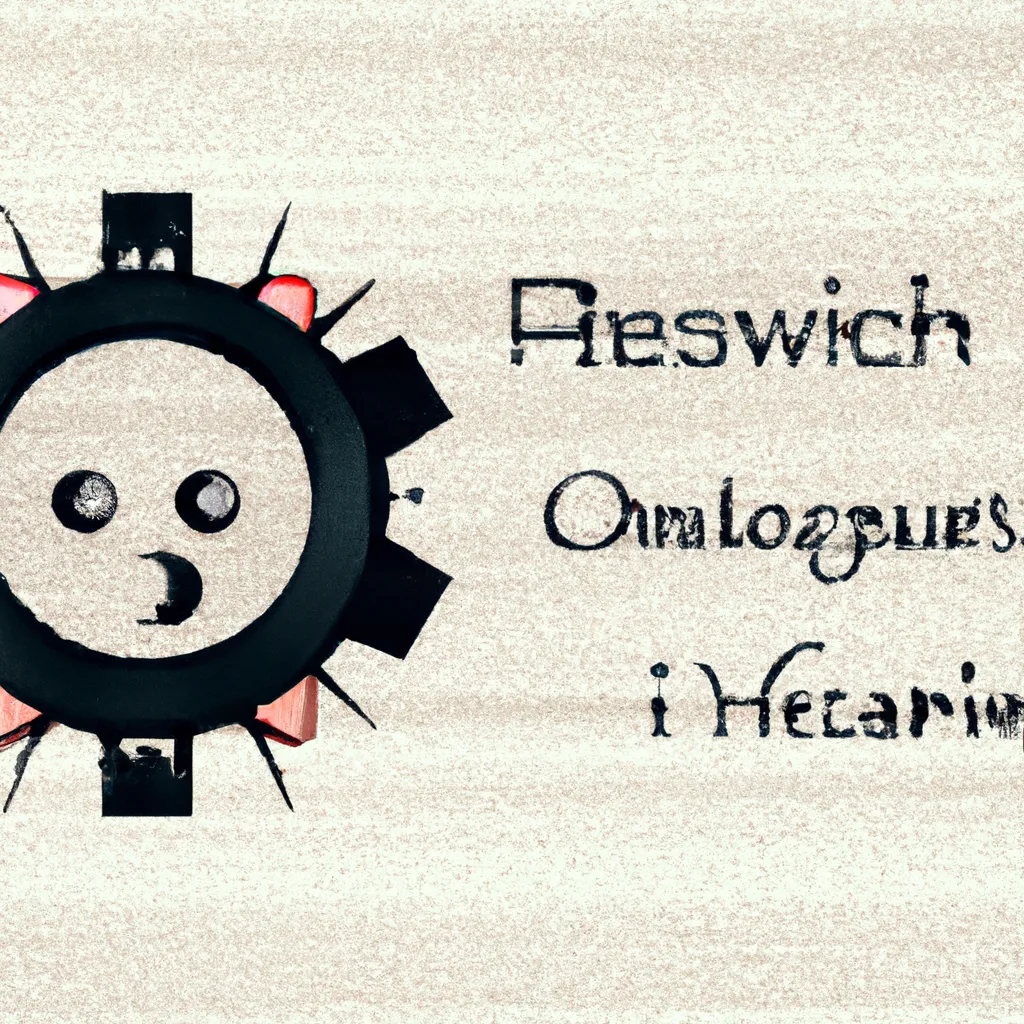
Can cats eat candy cane?
No, feeding your cat a candy cane is a definite no-no. While it might be tempting to give your kitty a lick of this festive sweet, it’s important to remember that cats’ digestive systems are not equipped to handle large amounts of sugar or certain flavors. The high sugar content in candy canes can lead to obesity and diabetes in cats, while the peppermint flavor can cause stomach upset and other serious health complications. Additionally, the hard texture of candy canes poses a choking hazard, making them doubly dangerous for your furry companion.
Can cats eat candy floss?
No, cats should not eat candy floss. Despite its enticing fluffiness and sweet allure, candy floss, also known as cotton candy, is unsuitable for feline consumption. High sugar content, a primary component of candy floss, can lead to obesity, diabetes, and dental problems in cats. Furthermore, the artificial colors and flavors used in candy floss can potentially harm your feline friend. Cats, being obligate carnivores, lack the necessary enzymes to properly digest sugars and other carbohydrates, making candy floss a poor dietary choice for them.
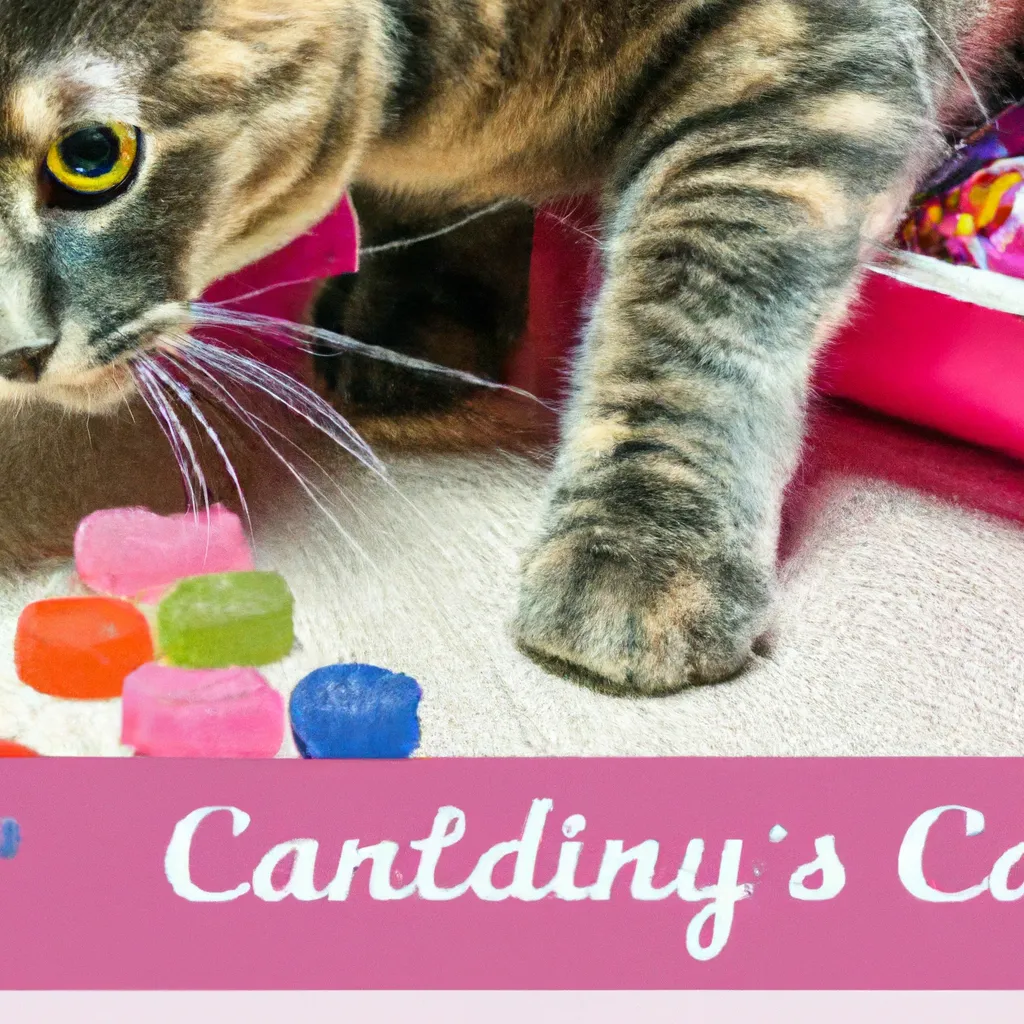
Are there safe alternatives to candy for cats?
While traditional candies and sweets are not recommended for cats, there are safe, cat-friendly alternatives available. Catnip, for instance, is a natural herb that many cats find irresistible and can be used as a safe treat. Additionally, various manufacturers produce cat treats that mimic the texture and flavor of human sweets, but are formulated with cat-safe ingredients. These treats often contain ingredients like chicken, fish, or other meats, and are usually fortified with essential vitamins and minerals. Remember to always consult with your veterinarian before introducing new foods into your cat’s diet to ensure they are safe and nutritionally balanced.
What is the best food for cats?
While the allure of sharing a sweet treat with your feline friend might be tempting, it’s essential to remember that the best food for cats is a balanced diet specifically designed for their unique nutritional needs, not candy. Cats, being obligate carnivores, thrive on a diet that is high in protein, moderate in fats, and includes very few, if any, carbohydrates. Commercially available, vet-approved cat food is typically formulated to meet these requirements, providing all the essential vitamins, minerals, and amino acids that cats require for optimal health. Candies, on the other hand, are laden with sugars and artificial ingredients that can lead to obesity, dental issues, and even serious health conditions like diabetes in cats. Furthermore, certain sweet treats like chocolate are toxic to cats and should be strictly avoided. So, while the occasional cat-safe treat can be a delightful addition to your pet’s diet, it’s best to stick to those that are specially formulated for cats, ensuring their dietary needs are met and their health is safeguarded. Remember, when it comes to our feline companions, their dietary needs are as unique as their personalities, and what’s sweet for us might not be so sweet for them.
Subscribe to our email newsletter to get the latest posts delivered right to your email.
